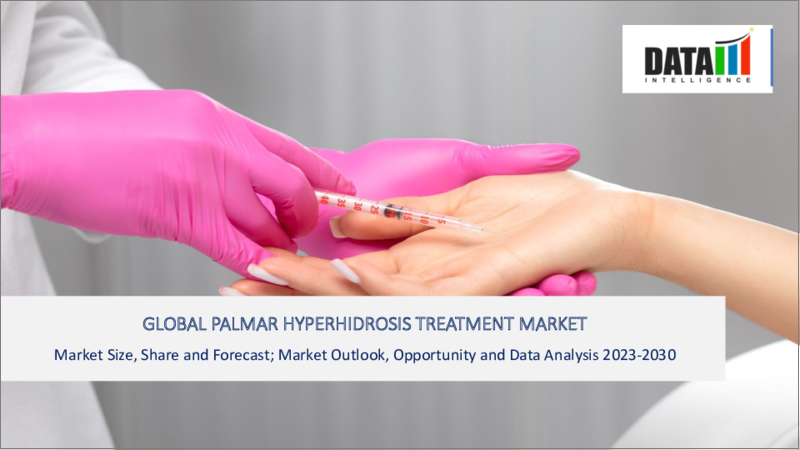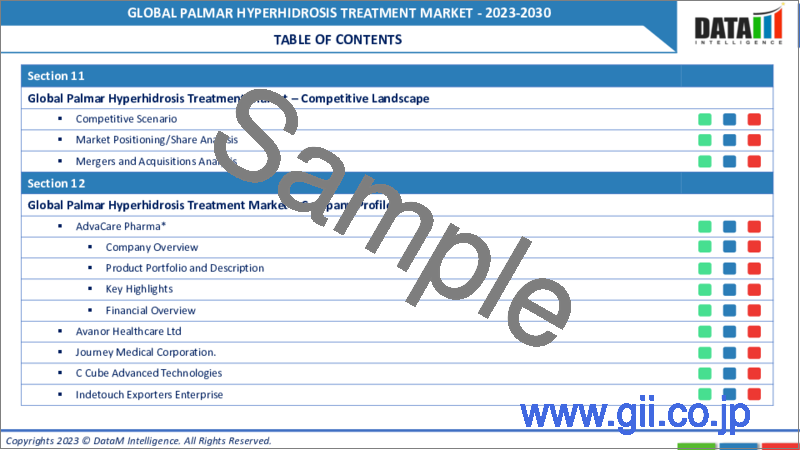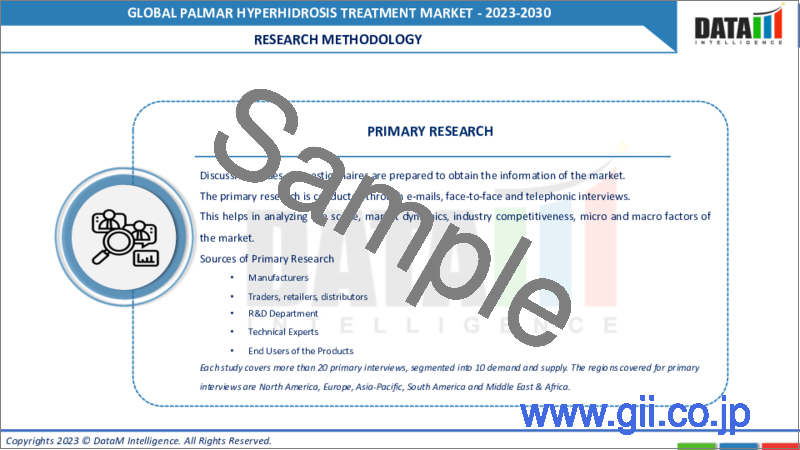|
|
市場調査レポート
商品コード
1374842
手掌多汗症治療の世界市場-2023年~2030年Global Palmar Hyperhidrosis Treatment Market - 2023-2030 |
||||||
カスタマイズ可能
適宜更新あり
|
|||||||
| 手掌多汗症治療の世界市場-2023年~2030年 |
|
出版日: 2023年11月01日
発行: DataM Intelligence
ページ情報: 英文 189 Pages
納期: 即日から翌営業日
|
- 全表示
- 概要
- 目次
概要
手掌多汗症は、手のひらに汗をかくことでも知られます。手掌多汗症の患者は、気温が低いときや安静にしているときでも汗をかくことがあります。手掌多汗症は、主に交感神経自律神経系の局所的な過活動から発症し、ストレス性の出来事が引き金となることもあります。手のひらの汗は、エクリン汗腺の過剰な活性化の結果です。
また、手掌多汗症の治療には、アルミニウムジルコニウムトリクロロ水和物や塩化アルミニウム六水和物などの制汗剤が主に汗腺の開口部に作用して汗の排泄を阻害したり、イオントフォレーシスという水に穏やかな電流を流して汗腺を一時的に遮断したりする方法が用いられます、抗コリン薬は、シナプス後ムスカリン受容体に対するアセチルコリンの作用を阻害し、汗腺の活性化を防ぐことで制汗効果を示すために使用されます。ボトックスは手掌多汗症の症状を緩和するのに有効であり、手汗が過剰な重症例では、内視鏡的胸部交感神経切除術(ETS)が手掌多汗症の最も適切な治療法です。
市場促進要因
イオントフォレーシス機器の採用増加
イオントフォレーシス機器の採用が増加していることが、予測期間中の市場を牽引すると予想されます。イオントフォレーシスは、皮膚表面に微弱な電流を流し、汗腺を一時的に遮断する非侵襲的な処置です。この非外科的アプローチは、侵襲性の低い治療を求める人々にアピールする可能性があるため、手掌多汗症治療の採用を増加させます。
例えば、ダーマドライは2022年10月7日、手足や脇の過剰発汗(多汗症)を治療するベストセラーのイオントフォレーシス機器のリニューアル・シリーズを発売しました。この装置は、世界的に多汗症に罹患している何百万人もの人々に適した、シームレスで快適、かつ楽な治療体験のために新しく生まれ変わりました。
さらに、イオントフォレーシスは、過剰な発汗を抑えるのに効果的であることが示されています。良好な治療成績と患者の満足度が、導入拡大に寄与している可能性があります。例えば、国際多汗症学会(International Hyperhidrosis Society)の調査によると、イオントフォレーシスは、手掌足底(手と足)の過剰発汗患者の91%に有効でした。また、別の研究では、イオントフォレーシスによって掌蹠発汗が81%減少したことが示されています。
この研究によると、イオントフォレーシスでは、医療機器を使用して、水(通常、手や足には浅いパン、その他の身体部位には特定のパッドを使用します)と皮膚表面に微弱な電流を流します。重大な副作用はなく、効果は長期にわたります。
さらに、イオントフォレーシス機器の中には家庭用に設計されたものもあり、医療施設に頻繁に通うことなく手掌多汗症を管理することができます。家庭で使用できる利便性は、普及の原動力となります。外科的介入に比べ、イオントフォレーシスは一般的に副作用が少ないため、侵襲的な処置に伴う潜在的リスクを懸念する人々にとって好ましい選択肢となります。
さらに、手掌多汗症の有病率の増加、FDA承認の増加、臨床試験の増加、新規治療薬に対する需要の増加、認知度の向上、技術の進歩などが、予測期間中に市場を牽引すると予想される要因です。
阻害要因
治療薬に伴う合併症や副作用、高額な治療費、代替治療オプションの利用可能性、利用可能な治療法に関する認識不足、一部の治療オプションの限定的な有効性などの要因が、市場の阻害要因になると予想されます。
目次
第1章 調査手法と調査範囲
第2章 定義と概要
第3章 エグゼクティブサマリー
第4章 市場力学
- 影響要因
- 促進要因
- イオントフォレーシス機器の採用拡大
- 抑制要因
- 治療に伴う副作用
- 機会
- 影響分析
- 促進要因
第5章 産業分析
- ポーターのファイブフォース分析
- サプライチェーン分析
- 価格分析
- 規制分析
- パイプライン分析
- アンメットニーズ
- 特許分析
- ボリューム分析
- DMIのオピニオン
第6章 COVID-19分析
第7章 疾患タイプ別
- 原発性局所多汗症
- 二次性全般性多汗症
第8章 治療タイプ別
- 制汗剤
- アルミニウムジルコニウムトリクロロヒドレート
- 塩化アルミニウム六水和物
- その他
- イオントフォレーシス
- 抗コリン薬
- オキシブチニン塩酸塩
- グリコピロレート
- ベンズトロピン
- プロパンテリン
- その他
- ボツリヌス毒素(ボトックス)
- 内視鏡的胸部交感神経切除術(ETS)
- その他
第9章 販売チャネル別
- 販売チャネル
- 病院薬局
- 小売薬局
- オンライン薬局
- エンドユーザー
- 病院
- 専門クリニック
- 皮膚科クリニック
- 学術研究機関
- その他
第10章 地域別
- 北米
- 米国
- カナダ
- メキシコ
- 欧州
- ドイツ
- 英国
- フランス
- イタリア
- スペイン
- その他欧州
- 南米
- ブラジル
- アルゼンチン
- その他南米
- アジア太平洋
- 中国
- インド
- 日本
- オーストラリア
- その他アジア太平洋
- 中東・アフリカ
第11章 競合情勢
- 競合シナリオ
- 市況/シェア分析
- M&A分析
第12章 企業プロファイル
- Allergan plc
- 会社概要
- 製品ポートフォリオと説明
- 財務概要
- 主な動向
- Thermo Fisher Scientific Inc.
- Journey Medical Corporation
- Revance Therapeutics, Inc.
- AdvaCare Pharma
- C Cube Advanced Technologies
- Avanor Healthcare Ltd
- Midas Pharma GmbH
- Galderma SA
- Indetouch Exporters Enterprise
第13章 付録
Overview
Palmar hyperhidrosis also known as sweaty palms, is a medical condition in which a person sweats excessively and unpredictably from their hands. People with palmar hyperhidrosis may sweat even when the temperature is cool or when they are at rest. It mainly evolves from a localized hyperactivity of the sympathetic autonomic system and it can be triggered by stressful events. Sweaty palms are the result of the overactivation of eccrine sweat glands.
Moreover, the treatment of palmar hyperhidrosis includes antiperspirants such as aluminum zirconium trichloro hydrate and aluminum chloride hexahydrate mainly act on the opening of the sweat glands blocking the elimination of sweat, iontophoresis by the process of sending gentle electrical current through water to shut down the sweat glands temporarily, anticholinergic drugs are used to display antiperspirant efficacy by blocking the effect of acetylcholine on postsynaptic muscarinic receptors, preventing sweat gland activation, botox is effective in relieving the symptoms of palmar hyperhidrosis and in severe cases with excessing hand sweating, Endoscopic Thoracic Sympathectomy (ETS) is the most appropriate cure for palmar hyperhidrosis.
Market Dynamics: Drivers
Increasing adoption of iontophoresis devices
The increasing adoption of iontophoresis devices is expected to drive the market over the forecast period. Iontophoresis offers a non-invasive procedure that involves passing a mild electric current through the skin's surface, temporarily blocking the sweat glands. This non-surgical approach may appeal to individuals seeking less invasive treatments thus increasing the adoption for palmar hyperhidrosis treatment.
For instance, on October 7, 2022, Dermadry launched a revamped range of its best-selling iontophoresis device to treat excessive sweating (hyperhidrosis) of the hands, feet, and underarms. This device has been reimagined for a seamless, comfortable, and effortless treatment experience suited for the millions of people affected by hyperhidrosis globally.
Moreover, iontophoresis has been shown to be effective in reducing excessive sweating. Positive outcomes and patient satisfaction may contribute to increased adoption. For instance, the International Hyperhidrosis Society organization study found that iontophoresis helped 91% of patients with excessive palmoplantar (hands and feet) sweating. Another study showed that iontophoresis reduced palmoplantar sweating by 81%.
According to the study, during iontophoresis, a medical device is used to pass a mild electrical current through water (usually using shallow pans for hands or feet or specific pads for other body areas) and through the skin's surface. There are no significant or serious side effects and the benefits are long-term.
In Addition, some iontophoresis devices are designed for home use, allowing individuals to manage their palmar hyperhidrosis without frequent visits to healthcare facilities. The convenience of home use can drive adoption. Compared to surgical interventions, iontophoresis typically has minimal side effects, making it a favorable option for those concerned about potential risks associated with more invasive procedures.
Further, the increasing prevalence of palmar hyperhidrosis, rising FDA approvals, increasing clinical trials, increasing demand for novel therapeutics, increasing awareness and technological advancements are the factors expected to drive the market over the forecast period.
Restraints
Factors such as complications and adverse effects associated with the treatment drugs, the high cost of the treatment, availability of alternative treatment options, lack of awareness about the treatments available, and limited efficacy of some treatment options are expected to hamper the market.
Segment Analysis
The global palmar hyperhidrosis treatment market is segmented based on disease type, treatment type, sales channel and region.
The anticholinergic drugs segment accounted for approximately 48.3% of the palmar hyperhidrosis treatment market share
The anticholinergic drugs segment is expected to hold the largest market share over the forecast period. Usually, sweating is controlled by the sympathetic nervous system, which releases the neurotransmitter acetylcholine to stimulate sweat gland activity. Anticholinergic drugs block the action of acetylcholine, reducing the stimulation of sweat glands. Anticholinergic drugs can have a systemic effect on the entire body, affecting sweat glands in various areas, including the palms. This makes them suitable for treating palmar hyperhidrosis.
For instance, on March 27, 2023, Hisamitsu Pharmaceutical Co., Inc. released that it had obtained approval for manufacturing and marketing of APOHIDE Lotion 20%, for the primary palmar hyperhidrosis treatment drug (generic name: oxybutynin hydrochloride) in Japan. Oxybutynin hydrochloride is a type of anticholinergic used is most commonly used for palmar hyperhidrosis.
Further, many anticholinergic drugs are administered orally and topiccally, providing a convenient and systemic approach to reducing sweating. This is particularly beneficial for individuals with widespread hyperhidrosis. Compared to surgical interventions, anticholinergic drugs offer a non-invasive treatment option. This can be appealing to individuals who prefer oral medications over more invasive procedures. In addition, their wide adoption also increases the demand for the anticholinergic drugs.
Geographical Analysis
North America accounted for approximately 39.7% of the market share
North America region is expected to hold the largest market share over the forecast period owing to the strong presence of major players and advanced healthcare facilities. North America especially the United States is known for its strong presence of major players such as pharmaceutical companies, biotechnology companies and medical device companies. The presence of major players actively performs the clinical trials to develop more accurate therapeutics for better patient outcomes.
For instance, on April 29, 2023, Aquavit Holdings, a biotechnology company focused on the development of botulinum toxin applications, received FDA clearance to initiate clinical trials for DTX-024, following its submission of Investigational New Drug Applications. Aquavit will begin its Phase III trials for DTX-024 (aqubotulinumtoxinA with intradermal microinjector) under the study protocol titled S.W.E.A.T. II (Safety with Efficacy of AQUATOX for palmar hyperhidrosis Trial).
Furthermore, the region is also known for its advanced healthcare infrastructure, including advanced medical facilities, specialized clinics, academic and research institutes and access to a wide range of treatment options. This facilitates the treatment of palmar hyperhidrosis by using advanced and appropriate therapeutics. As the research activities increase, the therapeutics are developed more precisely by reducing the adverse effects and complications associated with the therapeutics, which results in better patient outcomes.
Competitive Landscape
The major global players in the palmar hyperhidrosis treatment market include: Allergan plc, Thermo Fisher Scientific Inc., Journey Medical Corporation, Revance Therapeutics, Inc., AdvaCare Pharma, C Cube Advanced Technologies, Avanor Healthcare Ltd, Midas Pharma GmbH, Galderma SA and Indetouch Exporters Enterprise among others.
COVID-19 Impact Analysis
The COVID-19 pandemic significantly impacted the global palmar hyperhidrosis treatment market. During the pandemic, patients are hesitant to seek medical attention for palmar hyperhidrosis due to concerns about exposure to the virus. This led to a decline in the number of patients seeking treatment for palmar hyperhidrosis. The pandemic also created unprecedented challenges to the market by temporarily disrupting many clinical trials and research activities due to the redirected focus on the COVID-19 pandemic. The pandemic also disrupted the supply chain of these treatment drugs globally.
Market Segmentation
By Disease Type
- Primary Focal Hyperhidrosis
- Secondary Generalized Hyperhidrosis
By Treatment Type
- Antiperspirants
- Aluminum Zirconium Trichlorohydrate
- Aluminum Chloride Hexahydrate
- Others
- Iontophoresis
- Anticholinergic Drugs
- Oxybutynin Hydrochloride
- Glycopyrrolate
- Benztropine
- Propantheline
- Others
- Botulinum Toxin (Botox)
- Endoscopic Thoracic Sympathectomy (ETS)
- Others
By Sales Channel
- Distribution Channel
- Hospital Pharmacies
- Retail Pharmacies
- Online Pharmacies
- End-User
- Hospitals
- Specialty Clinics
- Dermatology Clinics
- Academic And Research Institutes
- Others
By Region
- North America
- U.S.
- Canada
- Mexico
- Europe
- Germany
- U.K.
- France
- Spain
- Italy
- Rest of Europe
- South America
- Brazil
- Argentina
- Rest of South America
- Asia-Pacific
- China
- India
- Japan
- Australia
- Rest of Asia-Pacific
- Middle East and Africa
Why Purchase the Report?
- To visualize the global palmar hyperhidrosis treatment market segmentation based on disease type, treatment type, sales channel and region as well as understand key commercial assets and players.
- Identify commercial opportunities by analyzing trends and co-development
- Excel data sheet with numerous data points of palmar hyperhidrosis treatment market-level with all segments.
- PDF report consists of a comprehensive analysis after exhaustive qualitative interviews and an in-depth study.
- Product mapping available as excel consisting of key products of all the major players.
The global palmar hyperhidrosis treatment market report would provide approximately 61 tables, 58 figures, and 189 Pages.
Target Audience 2023
- Manufacturers/ Buyers
- Industry Investors/Investment Bankers
- Research Professionals
- Emerging Companies
Table of Contents
1. Methodology and Scope
- 1.1. Research Methodology
- 1.2. Research Objective and Scope of the Report
2. Definition and Overview
3. Executive Summary
- 3.1. Snippet by Disease Type
- 3.2. Snippet by Treatment Type
- 3.3. Snippet by Sales Channel
- 3.4. Snippet by Region
4. Dynamics
- 4.1. Impacting Factors
- 4.1.1. Drivers
- 4.1.1.1. Increasing Adoption of Iontophoresis Devices
- 4.1.2. Restraints
- 4.1.2.1. Side Effects Associated with the Treatment
- 4.1.3. Opportunity
- 4.1.4. Impact Analysis
- 4.1.1. Drivers
5. Industry Analysis
- 5.1. Porter's Five Force Analysis
- 5.2. Supply Chain Analysis
- 5.3. Pricing Analysis
- 5.4. Regulatory Analysis
- 5.5. Pipeline Analysis
- 5.6. Unmet Needs
- 5.7. Patent Analysis
- 5.8. Volume Analysis
- 5.9. DMI Opinion
6. COVID-19 Analysis
- 6.1. Analysis of COVID-19
- 6.1.1. Scenario Before COVID
- 6.1.2. Scenario During COVID
- 6.1.3. Scenario Post COVID
- 6.2. Pricing Dynamics Amid COVID-19
- 6.3. Demand-Supply Spectrum
- 6.4. Government Initiatives Related to the Market During the Pandemic
- 6.5. Manufacturers Strategic Initiatives
- 6.6. Conclusion
7. By Disease Type
- 7.1. Introduction
- 7.1.1. Market Size Analysis and Y-o-Y Growth Analysis (%), By Disease Type
- 7.1.2. Market Attractiveness Index, By Disease Type
- 7.2. Primary Focal Hyperhidrosis*
- 7.2.1. Introduction
- 7.2.2. Market Size Analysis and Y-o-Y Growth Analysis (%)
- 7.3. Secondary Generalized Hyperhidrosis
8. By Treatment Type
- 8.1. Introduction
- 8.1.1. Market Size Analysis and Y-o-Y Growth Analysis (%), By Treatment Type
- 8.1.2. Market Attractiveness Index, By Treatment Type
- 8.2. Antiperspirants*
- 8.2.1. Introduction
- 8.2.2. Market Size Analysis and Y-o-Y Growth Analysis (%)
- 8.2.3. Aluminum Zirconium Trichlorohydrate
- 8.2.4. Aluminum Chloride Hexahydrate
- 8.2.5. Others
- 8.3. Iontophoresis
- 8.4. Anticholinergic Drugs
- 8.4.1. Oxybutynin Hydrochloride
- 8.4.2. Glycopyrrolate
- 8.4.3. Benztropine
- 8.4.4. Propantheline
- 8.4.5. Others
- 8.5. Botulinum Toxin (Botox)
- 8.6. Endoscopic Thoracic Sympathectomy (ETS)
- 8.7. Others
9. By Sales Channel
- 9.1. Introduction
- 9.1.1. Market Size Analysis and Y-o-Y Growth Analysis (%), By Sales Channel
- 9.1.2. Market Attractiveness Index, By Sales Channel
- 9.2. Distribution Channel*
- 9.2.1. Introduction
- 9.2.2. Market Size Analysis and Y-o-Y Growth Analysis (%)
- 9.2.3. Hospital Pharmacies
- 9.2.4. Retail Pharmacies
- 9.2.5. Online Pharmacies
- 9.3. End-User
- 9.3.1. Hospitals
- 9.3.2. Specialty Clinics
- 9.3.3. Dermatology Clinics
- 9.3.4. Academic And Research Institutes
- 9.3.5. Others
10. By Region
- 10.1. Introduction
- 10.1.1. Market Size Analysis and Y-o-Y Growth Analysis (%), By Region
- 10.1.2. Market Attractiveness Index, By Region
- 10.2. North America
- 10.2.1. Introduction
- 10.2.2. Key Region-Specific Dynamics
- 10.2.3. Market Size Analysis and Y-o-Y Growth Analysis (%), By Disease Type
- 10.2.4. Market Size Analysis and Y-o-Y Growth Analysis (%), By Treatment Type
- 10.2.5. Market Size Analysis and Y-o-Y Growth Analysis (%), By Sales Channel
- 10.2.6. Market Size Analysis and Y-o-Y Growth Analysis (%), By Country
- 10.2.6.1. U.S.
- 10.2.6.2. Canada
- 10.2.6.3. Mexico
- 10.3. Europe
- 10.3.1. Introduction
- 10.3.2. Key Region-Specific Dynamics
- 10.3.3. Market Size Analysis and Y-o-Y Growth Analysis (%), By Disease Type
- 10.3.4. Market Size Analysis and Y-o-Y Growth Analysis (%), By Treatment Type
- 10.3.5. Market Size Analysis and Y-o-Y Growth Analysis (%), By Sales Channel
- 10.3.6. Market Size Analysis and Y-o-Y Growth Analysis (%), By Country
- 10.3.6.1. Germany
- 10.3.6.2. UK
- 10.3.6.3. France
- 10.3.6.4. Italy
- 10.3.6.5. Spain
- 10.3.6.6. Rest of Europe
- 10.4. South America
- 10.4.1. Introduction
- 10.4.2. Key Region-Specific Dynamics
- 10.4.3. Market Size Analysis and Y-o-Y Growth Analysis (%), By Disease Type
- 10.4.4. Market Size Analysis and Y-o-Y Growth Analysis (%), By Treatment Type
- 10.4.5. Market Size Analysis and Y-o-Y Growth Analysis (%), By Sales Channel
- 10.4.6. Market Size Analysis and Y-o-Y Growth Analysis (%), By Country
- 10.4.6.1. Brazil
- 10.4.6.2. Argentina
- 10.4.6.3. Rest of South America
- 10.5. Asia-Pacific
- 10.5.1. Introduction
- 10.5.2. Key Region-Specific Dynamics
- 10.5.3. Market Size Analysis and Y-o-Y Growth Analysis (%), By Disease Type
- 10.5.4. Market Size Analysis and Y-o-Y Growth Analysis (%), By Treatment Type
- 10.5.5. Market Size Analysis and Y-o-Y Growth Analysis (%), By Sales Channel
- 10.5.6. Market Size Analysis and Y-o-Y Growth Analysis (%), By Country
- 10.5.6.1. China
- 10.5.6.2. India
- 10.5.6.3. Japan
- 10.5.6.4. Australia
- 10.5.6.5. Rest of Asia-Pacific
- 10.6. Middle East and Africa
- 10.6.1. Introduction
- 10.6.2. Key Region-Specific Dynamics
- 10.6.3. Market Size Analysis and Y-o-Y Growth Analysis (%), By Disease Type
- 10.6.4. Market Size Analysis and Y-o-Y Growth Analysis (%), By Treatment Type
- 10.6.5. Market Size Analysis and Y-o-Y Growth Analysis (%), By Sales Channel
11. Competitive Landscape
- 11.1. Competitive Scenario
- 11.2. Market Positioning/Share Analysis
- 11.3. Mergers and Acquisitions Analysis
12. Company Profiles
- 12.1. Allergan plc*
- 12.1.1. Company Overview
- 12.1.2. Product Portfolio and Description
- 12.1.3. Financial Overview
- 12.1.4. Key Developments
- 12.2. Thermo Fisher Scientific Inc.
- 12.3. Journey Medical Corporation
- 12.4. Revance Therapeutics, Inc.
- 12.5. AdvaCare Pharma
- 12.6. C Cube Advanced Technologies
- 12.7. Avanor Healthcare Ltd
- 12.8. Midas Pharma GmbH
- 12.9. Galderma SA
- 12.10. Indetouch Exporters Enterprise
LIST NOT EXHAUSTIVE
13. Appendix
- 13.1. About Us and Services
- 13.2. Contact Us





